Build a Powerful B2B Email Database
October 16, 2025
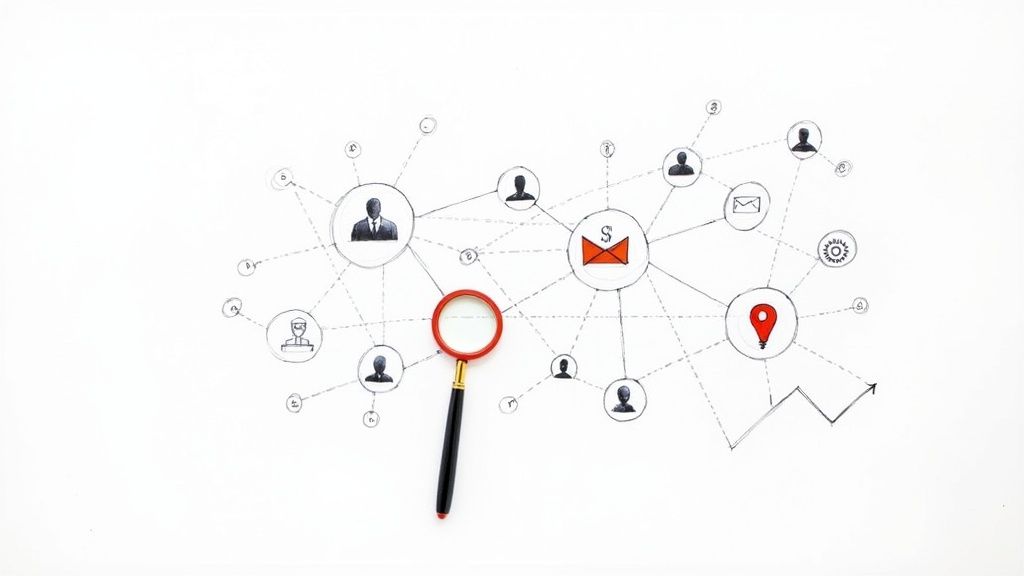
A B2B email database is so much more than a contact list—it’s the heart of your entire marketing and sales engine. When you build and maintain it properly, it becomes a powerful asset that fuels real conversations, forges relationships, and drives sustainable growth for your business.
Your Database Is Your Growth Engine, Not Just a Spreadsheet
Let's get one thing straight: if you're treating your B2B email database like a static spreadsheet, you're setting yourself up for failure. Too many teams fall into the trap of viewing it as just a list of names to blast with generic messages.
This isn't just a technical mistake; it’s a massive strategic blunder. That approach inevitably tanks your engagement, scars your sender reputation, and burns through resources on campaigns that go nowhere. A poorly managed list guarantees your message gets lost in the noise, making a genuine connection impossible.
The Real Power of a Well-Kept Database
Now, let’s flip that scenario. A clean, thoughtfully segmented database changes your outreach from a monologue into a dialogue. Suddenly, you can deliver the right message to the right person at exactly the right time. This isn’t just about dodging the spam folder—it's about earning the attention of busy decision-makers who are tired of irrelevant noise.
A high-quality database is the foundation for a much smarter approach, allowing you to:
- Build Real Relationships by sending content that speaks directly to a prospect’s specific challenges and needs.
- Boost Conversions because your communication is timely, personal, and actually valuable to them.
- Protect Your Brand by ensuring your emails land in the inbox, keeping your deliverability high and bounce rates low.
The difference between a neglected list and a nurtured one isn't just a small improvement—it's exponential. One drains your resources, while the other builds compounding value and opens doors to your most important accounts.
The chart below shows the night-and-day difference in key metrics between a messy database and a clean, segmented one. The numbers don't lie.
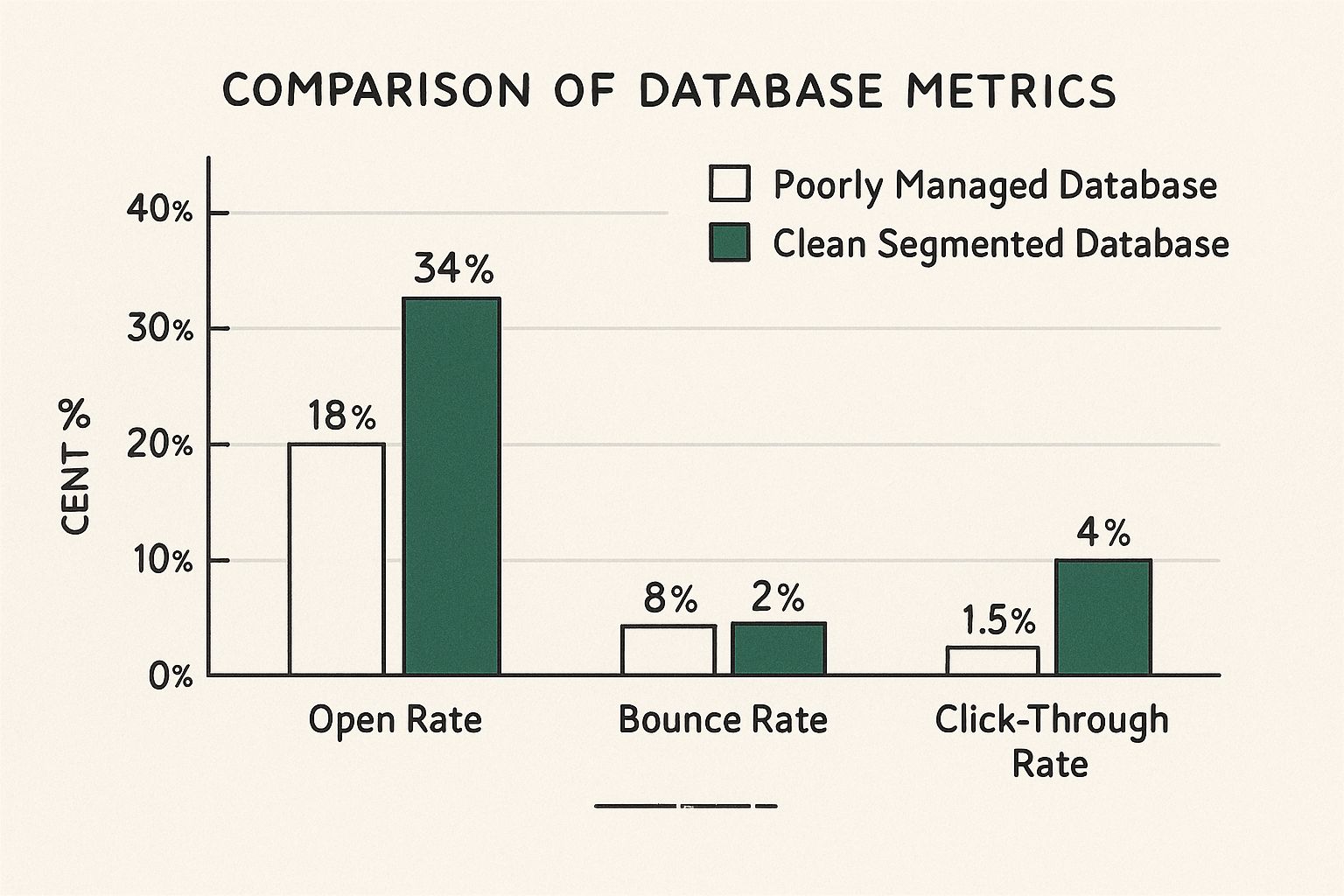
As you can see, a well-maintained database can nearly double your open rates while slashing bounces. Taking the time to cultivate this asset is a non-negotiable part of any successful B2B outreach effort today. To see how this fits into the bigger picture, check out our guide on building a data-driven marketing strategy.
Acquiring High-Quality B2B Contacts Ethically
Building a powerful B2B email database starts with sourcing contacts the right way. Forget about those shady, purchased lists that promise the world but only deliver dead ends, angry replies, and a tarnished brand reputation. It just isn't worth it.
The most valuable contacts—the ones that actually lead to business—are those who choose to hear from you because you offer genuine value from the very first touchpoint.
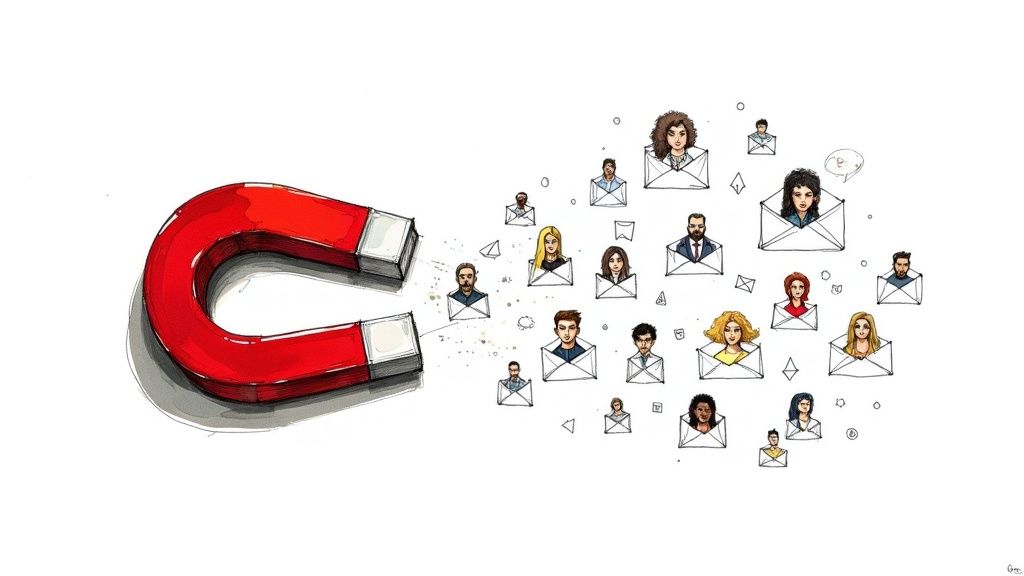
This is a game of attraction, not interruption. Instead of chasing down cold leads, you create resources and opportunities that pull your ideal customers into your orbit. This opt-in approach doesn't just keep you compliant; it builds a foundation of trust that results in much higher engagement down the line.
Create Irresistible Lead Magnets
The core of ethical acquisition is a simple value exchange. You offer something incredibly useful, and in return, a prospect gives you their contact information. This isn't a trick; it's a fair trade that respects their time and intelligence.
Your lead magnets need to hit a real nerve, addressing a pressing pain point for your target audience. Imagine a SaaS company targeting VPs of Marketing. A generic newsletter signup won't cut it. Instead, they could host a hyper-specific webinar on "AI-Powered Budget Allocation for Q4." Now that speaks directly to a key responsibility and pulls in decision-makers who are actively looking for solutions.
Effective lead magnets I've seen work time and again include:
- In-depth whitepapers with original research or a unique perspective on an industry problem.
- Exclusive webinars or workshops that deliver actionable training and expert insights.
- Practical templates or checklists that genuinely help professionals do their jobs better.
Pinpoint Decision-Makers with Precision Tools
While inbound is powerful, targeted outbound outreach still has a place—when it's done right. This is where tools like LinkedIn Sales Navigator become invaluable, letting you identify ideal decision-makers using incredibly specific filters like company size, role, industry, and even recent activity.
The key is using this information for personalization, not spam. Reference a shared connection, a recent company announcement, or a post they engaged with. This shows you've done your homework and are starting a relevant conversation, not just firing off another cold email blast. To see how this fits into the bigger picture, a detailed look into the lead generation process is a great next step.
The goal is to build a list of people who are genuinely interested in what you have to say. Short-term wins from purchased lists almost always lead to long-term deliverability issues and a tarnished brand reputation.
So, how do these different methods stack up? Choosing where to focus depends on your resources and goals.
Ethical B2B Contact Sourcing Methods
Here's a quick comparison of a few ethical sourcing methods to help you decide where to invest your energy.
Each of these channels offers a different trade-off between effort and the quality of the contact you'll acquire. Webinars, for example, are a heavy lift but often produce the most engaged leads.
Ultimately, building your B2B email database is a continuous process of providing value and earning trust. For a deeper dive into this, our guide on B2B lead generation provides even more actionable strategies. Every contact you get through these methods represents a potential relationship, not just another entry in a spreadsheet. This patient, value-first approach is what truly drives sustainable growth.
Mastering Data Verification and Cleansing

Let's be honest: an unverified B2B email database is a leaky bucket. With every campaign you send, you're not just wasting time and money—you're actively damaging your sender reputation.
People switch companies, get promoted, and abandon old email addresses far more often than we'd like to think. This natural data decay leads straight to high bounce rates. Plugging those leaks isn't a one-and-done chore; it's a strategic, ongoing process that protects your brand and ensures your messages actually land in front of real, relevant people.
The Power of Automated Verification
When you're dealing with any B2B list of significant size, trying to verify it manually is a fool's errand. It's just not possible. This is where automated tools become your best friend, acting as a powerful first line of defense against bad data.
I've seen services like NeverBounce or ZeroBounce work wonders. You can upload your entire list in bulk, and they’ll quickly process it to identify and flag invalid or risky email addresses.
These platforms are checking for a few key things:
- Syntax Errors: Obvious typos and formatting mistakes (like
contact@company,com). - Domain Validity: Does the company's domain even exist and can it receive mail?
- Mailbox Status: Is this specific mailbox active and accepting emails right now?
- Catch-All Servers: These are domains that accept all emails sent to them, which can be risky for deliverability and are good to be aware of.
Running your list through one of these services before a major campaign is a quick win. It can immediately slash your bounce rate by several percentage points. It’s a small investment that pays for itself by protecting your precious sender score.
Implementing a Regular Cleansing Cadence
Here’s the thing about data verification: you can't just set it and forget it. The B2B world moves fast, and contact data has a surprisingly short shelf life. In fact, some research suggests that B2B data decays at a staggering rate of over 22% per year. You have to stay ahead of it.
A quarterly cleansing schedule is a solid rhythm for most businesses. This means running your entire database through a verification tool every three months and purging any contacts flagged as invalid or high-risk. This simple habit keeps your list healthy and your deliverability strong. You can actually see how this small task fits into the bigger picture in our guide to B2B marketing analytics for growth.
Think of data cleansing like regular maintenance on a high-performance engine. Skipping it might not cause an immediate breakdown, but over time, performance will degrade until your entire marketing machine grinds to a halt.
Beyond just verifying addresses, you also need to look at engagement. Contacts who never open or click your emails are dead weight. They drag down your metrics and signal to email providers that your content might be unwanted.
Create a segment of subscribers who haven't engaged in the last 90 or 120 days. You can try one last re-engagement campaign to win them back, but if that doesn't work, it's time to say goodbye. Removing these inactive contacts is one of the most powerful moves you can make to boost your overall open and click-through rates. Seriously.
Unlocking Growth with Smart Segmentation
Sending the same generic message to everyone in your B2B email database is a guaranteed path to the unsubscribe button. We’ve all been there. You get an email that’s so far off base, you wonder how you ever got on their list in the first place.
Real marketing power isn’t in the size of your list, but in your ability to speak directly to the unique needs of each contact on it. This is where smart segmentation transforms your database from a blunt instrument into a precision tool.
It’s all about slicing your database into smaller, meaningful groups to deliver hyper-relevant content that actually connects. But don’t stop at the basics like company size or industry—those are just table stakes. The real opportunity lies in going deeper.
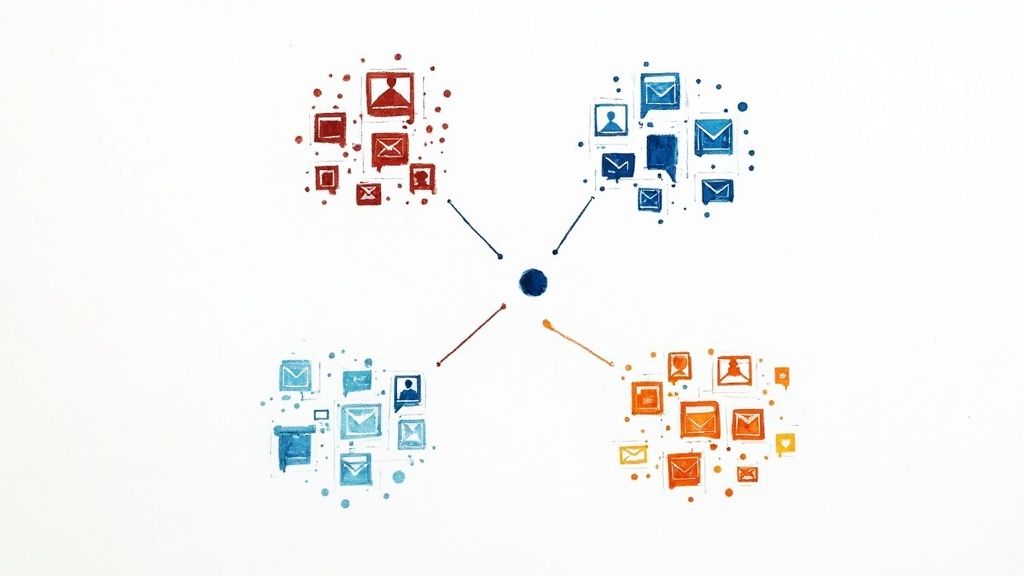
Go Beyond Firmographics with Behavioral Data
While knowing a contact's industry or job title is a solid starting point, the most impactful segmentation is rooted in behavior. Think of it as their digital body language—grouping contacts based on how they actually interact with your brand.
This approach lets you tailor your messaging based on genuine interest and intent. You move from making assumptions to responding to clear signals they're sending you.
The goal is to create conversations that feel personal and timely, not automated and generic. Behavioral segmentation makes your contacts feel understood, building trust and inspiring them to take the next step.
Here are a few powerful behavioral segments I've seen work wonders:
- Content Engagement: Group contacts by the specific whitepapers they’ve downloaded, webinars they’ve attended, or blog posts they’ve read.
- Website Activity: Segment users who have visited your pricing page multiple times or spent significant time exploring a specific product feature. These are hot leads.
- Email Interaction: Create lists for your most engaged subscribers (high open and click rates) or those who have clicked on specific links within past campaigns.
Let’s say you hosted a webinar on "AI in Financial Forecasting." Instead of blasting a generic follow-up to your entire list, you can send a tailored case study on a similar topic exclusively to those who attended. This laser-focused approach dramatically increases the odds of conversion because the content directly aligns with their demonstrated interest.
Put Segmentation into Action
Let’s translate this into a real-world application. Imagine a B2B SaaS company that wants to nurture leads with incredible precision.
This level of personalization is quickly becoming essential. By 2025, it’s expected that 54% of marketers will personalize email content, and that number is only going to climb. According to research from Hostinger on email personalization, advanced marketers are already using behavioral data and purchase history to make every message count. It’s no surprise that automated, behavior-triggered emails can deliver conversion rates four times higher than standard campaigns.
Building these segments is often deeply connected to understanding your ideal customers. A great way to sharpen your segmentation strategy is by using buyer personas to accelerate B2B marketing and sales, which helps you define the very groups you aim to target.
How to Maintain and Grow Your Database
Think of your B2B email database as a living asset, not just a static file you set up once and forget about. To get real, compounding value out of it, you have to treat it with a bit of stewardship. This continuous care and strategic growth is what separates fleeting campaigns from a sustainable growth engine.
This long-term health isn't just about periodic cleanups. It’s about building systems that intentionally nurture and expand your list, ensuring every contact remains a valuable connection.
Implement Progressive Profiling for Deeper Insights
One of the most effective ways to enrich your database without scaring people off is progressive profiling. Instead of hitting a new contact with a massive, intimidating form, you ask for information gradually over multiple interactions.
For example, a first-time content download might only require an email. Simple. The next time they engage, maybe you ask for their company name and job title. This patient, relationship-focused approach respects their time and allows you to build a much richer contact profile with each touchpoint.
This method helps you:
- Increase initial conversion rates by keeping the barrier to entry super low.
- Gather more accurate data over time without causing friction or frustration.
- Enable more sophisticated segmentation as you learn more about each contact's role and needs.
Create Evergreen Content Funnels
If you want a consistent stream of new, qualified subscribers, you need evergreen content funnels. These are your heavy hitters—think ultimate guides, comprehensive toolkits, or on-demand webinars that stay relevant long after you hit publish.
An evergreen funnel acts as your 24/7 lead generation machine. It continuously draws in ideal prospects and adds them to your B2B email database, ensuring your growth isn't reliant on one-off marketing pushes.
Promote these cornerstone assets across your channels to create a steady flow of new contacts. This strategy ensures your list is always growing with people actively seeking the solutions you provide. To make this process even more powerful, you can learn how to use marketing automation in B2B to nurture these new leads from the moment they subscribe.
Revive Your List with Re-Engagement Campaigns
Before you hit delete on inactive subscribers, give them one last chance to reconnect. A re-engagement campaign is a targeted effort to win back contacts who have stopped opening or clicking your emails. This isn’t just about cleaning your list; it's about salvaging valuable relationships you’ve already invested in.
Your campaign could be a simple, personalized email asking if they still want to hear from you or maybe offering an exclusive piece of high-value content. If they engage, great—they're still interested. If they don't, you have a clear signal it's time to let them go, which ultimately protects your deliverability.
This focus on maintenance is non-negotiable, especially when you consider the sheer volume of modern business communication. Projections show that over 347 billion emails will be sent and received daily in 2025. That staggering figure is exactly why a clean, engaged database is essential for cutting through the noise. You can discover more insights about these email statistics to really grasp the importance of every single email you send.
Got Questions? We've Got Answers
Navigating the world of B2B email databases brings up some tough questions. I get it. Here are some direct answers to the most common challenges I see founders and marketers face, with clear, actionable advice to help you build an asset that actually drives growth.
How Often Should I Clean My B2B Email Database?
Think of data hygiene as a continuous process, not a one-time event. The B2B world moves fast—people are constantly changing jobs, getting promoted, or switching companies. Your data starts decaying the moment you collect it.
For most businesses, a full verification and cleansing of the entire database should happen at least quarterly. This is your deep clean.
But just as important is verifying new contacts as they come in. This proactive step is crucial. It stops bad data from ever polluting your system in the first place, protecting your sender reputation from day one.
Is Buying a B2B Email List a Good Idea?
This is a tricky one, and honestly, it’s filled with landmines. While buying a list feels like a shortcut to growth, it’s incredibly risky if you're not careful.
Lists from shady sources are almost always packed with outdated contacts, irrelevant leads, or even spam traps that can absolutely destroy your deliverability and get your domain blacklisted. Seriously, it's not worth the headache.
However, there are reputable data providers that can offer verified, targeted lists that give you a starting point for specific campaigns. If you go this route, always choose a provider that guarantees data quality and compliance with privacy laws. Even then, your first outreach has to be about genuine value, not a hard sales pitch. Tread lightly.
What's the Best Way to Grow My Database Organically?
The most sustainable way to grow your B2B email database is by creating resources that pull your ideal customers to you. Instead of chasing contacts, make them want to connect with you. It’s all about a fair value exchange.
Here are a few ways to do it right:
- Host expert webinars that solve a specific, high-stakes problem your target audience is struggling with right now.
- Develop in-depth whitepapers or research reports that offer unique industry insights they can't find anywhere else.
- Create practical templates or checklists that genuinely help professionals do their jobs better and more efficiently.
The core principle is simple: You provide undeniable expertise, and in return, a prospect willingly gives you their contact information. This isn't just lead gen; it's the beginning of a relationship built on trust, which leads to a highly engaged subscriber list.
The ROI from this approach is undeniable. B2B email marketing consistently delivers returns of $36 to $42 for every $1 spent. Yet, a surprising 59% of B2B marketers don't use it, even though they know how important it is. You can discover more insights about B2B email benchmarks to see the full picture of this massive opportunity.
Ready to turn your B2B marketing into a revenue-driving machine? At Big Moves Marketing, I help B2B SaaS and AI startups build the positioning, sales tools, and launch strategies that win deals. Let's create a plan that delivers real results. Learn more at Big Moves Marketing.
%20-%20Alternate.svg)
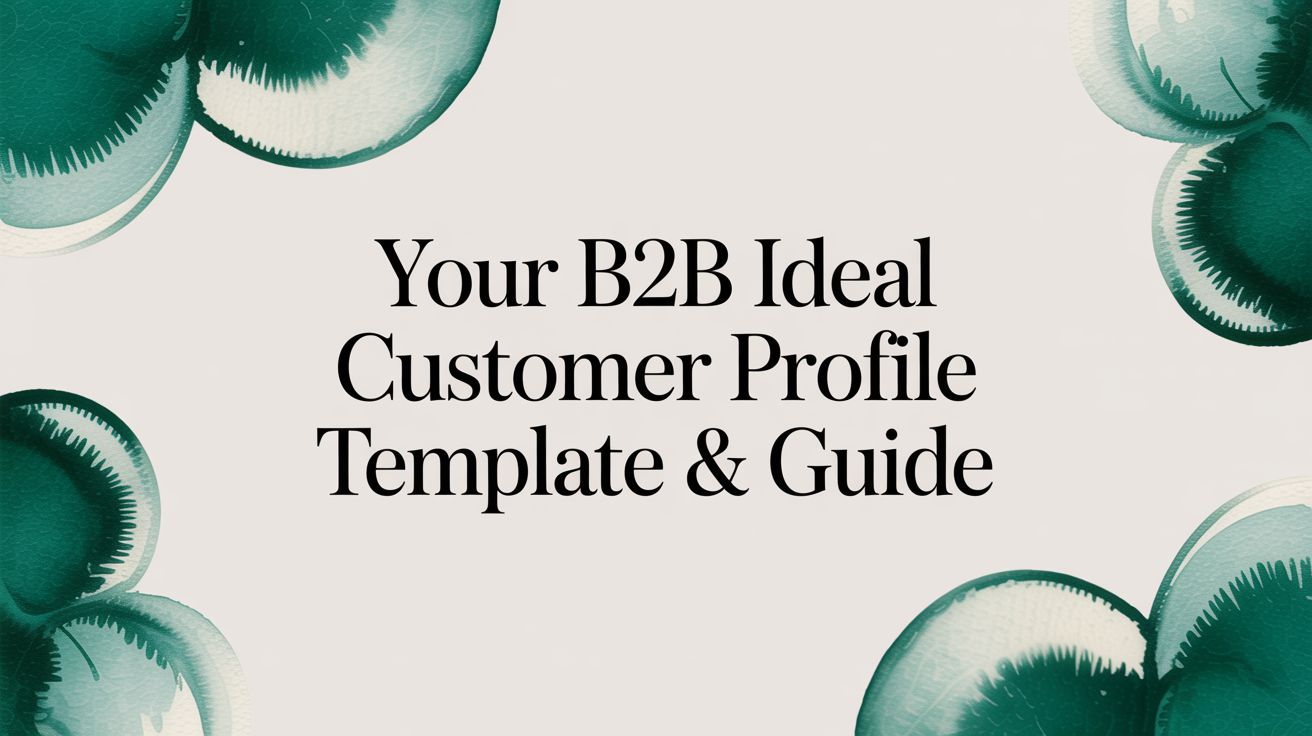

%20-%20white.svg)